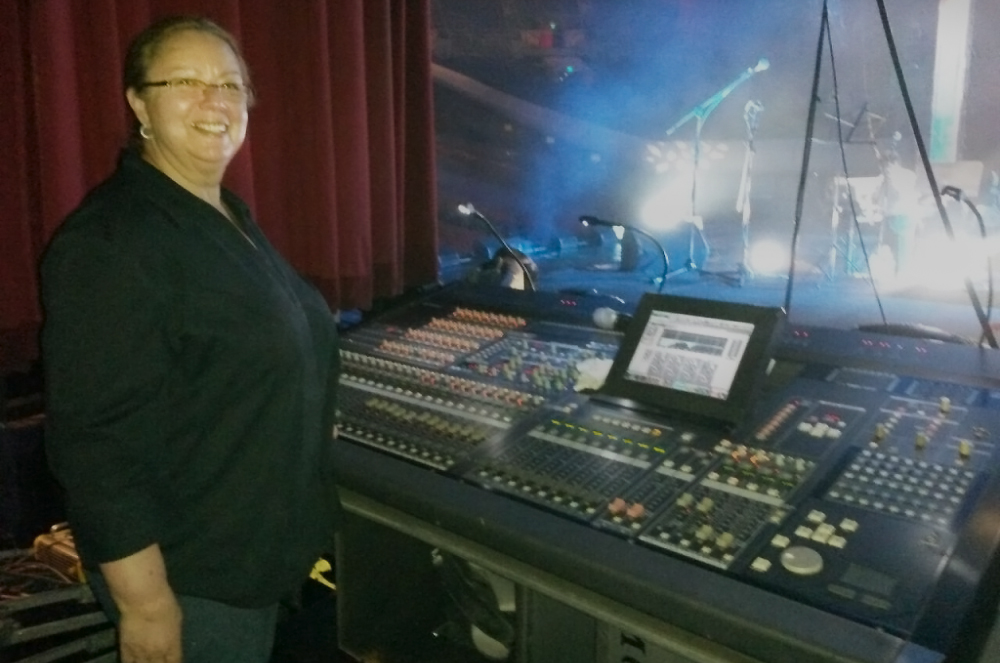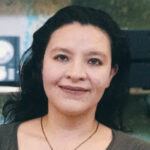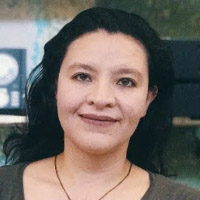Editor’s Note: It is with great sadness that we learned of the passing of Griselda (1953–2022) just as we were getting set to feature this article. Please enjoy this account of her wonderful career as a true pioneer in professional audio, and our sincere thanks to SoundGirls for sharing it with us.
Griselda Jiménez is the first woman sound engineer in México, working for Vicente Fernández (among many other representative icons of Mexican popular music) for more than 30 years. Her hallmark, beyond her professionalism and dedication, was her interest in transmitting what the artist is feeling, which is why artists wished to work with her.
Griselda came from a family that was directly related to sound – her parents were involved in the rental services of musical instruments and audio equipment where she learned how to use and manage them, but her dream was to become a dancer. “I learned everything about the sound when once, as an artist on a tour, my father, who was in charge of the sound, got sick and went back to Guadalajara,” she explains. “I had to take care of the sound at the same time I was performing, that’s how I learned. Actually, I didn’t like it, I had to do it because my father made me do it. I was only an actress and a dancer.”
In 1969, Griselda began a career as a dancer in las caravanas of the Blanquita Theater in Guadalajara. A couple of years later she moved to Mexico City and worked as a substitute dancer for the company of the same theater where the actress Margarita Su López, also known as Margo Su, was in charge. It’s relevant to note that Margo Su was an important writer and a theater entrepreneur during the Golden Age of Mexican Cinema.

In The Beginning
Working in this venue opened a window where Griselda received her first introduction to live sound mixing, where unusual circumstances provided the opportunity to oversee the theater audio. “Thanks to the unprofessional behavior of the staff, I had the opportunity to be in charge of the audio,” she recalls. “I remember that the audio manager got drunk and had an argument with Lucha Villa (and icon of Mexican music), who knew I had knowledge about audio so she told me ‘you’re in charge’ and fired the guy.”
It was at that moment that her journey began as a live sound engineer. At first, she did seasonal work with comedians and artists such as Lucha Villa, one of the most important singers in regional Mexican music. This association proved vital since Villa was the first person who believed in her, and she went on to work with noted artists such as Pepe Jara, Juan Gabriel, Imelda Miller, Los Platers, La Sonora Santanera, Irma Serrano, Los Panchos, Pérez Prdo, Lola Beltrán, Jiménez Sisters, Vicente Fernández and many others.
The key tools in her development are the hallmarks of modesty and professionalism exhibited throughout her career, basic principles that have helped keep her in the industry for several decades. In 1982, she met the icon who marked her career, Vicente Fernández, who had taken issue with the attitudes of audio engineers.
As a result, Fernández thought it would be better if he worked with a woman engineer and offered Griselda a full-time job. Coincidentally, the engineers he had trouble with were her brothers, so her immediate reaction was to reply, “No sir, you’re my brothers’ artist and I won’t get in the middle of that” – but her family advised her to take the job.
About five years ago, after more than 33 years of touring, Fernández left the stage, with Griselda deciding to do the same. However, popular Mexican singer/actress Edith Márquez asked to work with her for a few dates since Griselda has long viewed her as a daughter because of her big heart and human quality. The resulting shows featured her final sound mixes before she officially retired. (Editor’s Note: Unfortunately, Don Vicente Fernandez also passed away in December of 2021 without knowing that the following month Griselda would also pass away.)

Empirical Knowledge
Her entry into the industry was a time when there were no schools to study sound engineering, so Griselda acquired her knowledge by practicing, experiences, and meeting day-by-day challenges. Adrenaline was the key for choosing live sound, although she worked on some projects inside the studio, but it wasn’t the same experience and sensation that comes from working on stage with artists.
“I started to learn in an empirical way by watching TV shows, but where I truly learned was when we were touring with Vicente in the United States,” she says. “The audio engineers that worked there were curious about the fact that there was a Mexican woman sound engineer and they helped me.
“At first it was quite difficult to be in an industry where there were no women working on the technical side,” she adds, but with her personality, tenacity, and the support of the people like her husband Miguel Lara (who she married in 1975, widowed in 2012) and with a tight-knit crew of Enrique Díaz, Fidel Pérez, and Diego Valdivia (who were always by her side), she earned the respect of numerous professionals and a place in the industry: “As a woman in a job for men, it was complicated but not impossible.”
She credits her previous non-audio experiences with informing her work as well: “I started as a dancer, and maybe because I had my musical sense developed it helped me to mix. For me, everything started as a surprise that evolved into a necessity and challenge that I didn’t want. I had complicated, scary and sad moments, and although I was afraid of the unknown, I constantly said I could achieve it, remembering my daughters Imelda and Rocío had given me all their support to overcome any obstacle.”
Griselda specialized in monitors, where she notes, “As a monitor engineer, it’s key, no matter the mood of the artist, to feel my support. In the case of Vicente, the monitor system was eight floor monitors just for him, a few more for his musicians, and six side fill points. Everyone said he was putting a PA for monitors, which was shocking. I would say that the sound pressure level was around 100 dB.
“The first sound that the artist made was crucial,” she continues. “If everything was good he would see me with total confidence, and then I knew his sound was just as it was supposed to be. Sometimes he even told me to lower the level.” The word started to get out and other artists started to ask for the same monitor system.
Fernández only employed three microphones: one for the violins, another for harmonies, and the last for trumpets. It was an approach Griselda didn’t agree with, she says, explaining, “So I taught him how to make a mariachi sound. He used to say that people went to listen to him, not the mariachi, but I always told him that without the mariachi the people would never know the songs. It was kind of difficult to work with him, but step by step I changed his mind.
“I also made him use wireless microphones, to the point where he stopped using cable microphones because they made his outfit dirty,” she remembers. “Later I worked closely with his musicians because when the show started, they moved back so they could hear themselves – the reason was they weren’t miked correctly. I changed that so they could hear themselves, as it was supposed to be.”
Equipment preferences changed over the years, as Griselda notes, “You have to learn, improve, and be updated every day.” She started out with a pair of Cerwin Vega loudspeakers and a monitor console that were hauled in a 1980 Dodge truck, always with her husband by her side in support.
“At that time, having the right equipment was complicated, which is why I didn’t have any type of preferences, with microphones as an exception, where I always used Shure and Sennheiser,” she says. “Whatever they put me in front, I would make it work.”

Against that backdrop, let’s learn more with a Q&A session.
Question: What do you like best about touring?
Griselda: I like traveling very much and being able to sound check in different venues.
Q: What’s your favorite day off activity?
Griselda: To be at my home with my husband and daughters. Enjoying my family and my life.
Q: What, if any, obstacles or barriers have you faced?
Griselda: There are many obstacles but all of them can be overcome.
Q: How have you dealt with them?
Griselda: With a lot of persistence, love, honesty and the most important thing is to be constant all the time.
Q: Advice you have for young women who wish to enter the field?
Griselda: Don’t lose the passion and love for the profession, ignore negative comments, keep updating all the time don’t compare yourself with anyone – each one of us is unique and we have our own mix styles.
Our thanks to SoundGirls for sharing this article.















